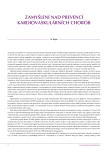Ezetimibe – simvastatin fixed combination of (inegy) in the treatment of hypercholesterolemia – combination therapy or monotherapy?
Authors:
R. Češka
Authors‘ workplace:
III. interní klinika 1. LF UK a VFN, Praha
; Centrum preventivní kardiologie
Published in:
Kardiol Rev Int Med 2007, 9(2): 114-119
Category:
Editorial
Overview
Comprehensive approach to treatment and influencing several risk factors at the same time are attributed a growing importance in preventive cardiology today. In addition, the trend is to achieve the lowest possible target values by the treatment (hypertension, lipids, diabetes, etc.). As a result, combination therapy is the logical outcome which apart from the benefit (high efficiency) also brings about certain discomfort for the patients having to take a higher number of pills. The introduction of fixed combinations (involving 2 or even more active substances) is a modern approach offering at least partial solution of the above issue. Combination therapy of hyperlipoproteinemias and dyslipidemias (HLP and DLP) is a modern trend in the therapy of lipid metabolism disorders. Combination therapy allows for achieving target values in a higher number of patients, the therapy is welltolerated and is generally safer than the administration of a high monotherapy dose. Ezetimibe – statin is the combination to be used in the first place today for the reduction of LDL-C. However, older and well-proven combinations (statin plus resin, or the “rediscovered” combination of statin and niacin) should not be ignored either, and the paper gives a review of knowledge concerning primarily the fixed combination of ezetmimb and simvastatin, which is today registered in the Czech Republic under the INEGY brand name. It should be added, however, that combination therapy resulting in the reduction of LDL-C is sufficiently evidence-based.
Keywords:
statins – ezetimibe – simvastatin – apolipoprotein B – LDL-cholesterol – fixed combination – Inegy
Sources
1.Reddy KS. The Preventive Polypill-Much Promise Insufficient Evidence. N Engl J Med 2007; 356 : 212.
2.Nissen SE, Tuzcu EM, Schoenhagen P et al. Effect of intensive compared with moderate lipid-lowering therapy on progression of coronary atherosclerosis. A randomised controlled trial. JAMA 2004; 291 : 1071-1080.
3.Cannon CP, Braunwald E, McCabe HC et al. Intensive versus moderate lipid lowering with statins after acute coronary syndromes. N Engl J Med 2004; 350 : 1495-1504.
4.Ballantyne M, Abate N, Yuan Z et al. Dose-comparison study of the combination of ezetimibe and simvastatin (Vytorin) versus atorvastatin in patients with hypercholesterolemia: The Vytorin Versus Atorvastatin (VYVA) Study. Am Heart J 2005; 149 : 464-473.
5.Ballantyne,CM, Blazing MA, King TR et al. Efficacy and Safety of Ezetimibe Co-Administered With Simvastatin Compared With Atorvastatin in Adults With Hypercholesterolemia. Am J Cardiol 2004; 93 : 1487-1494.
6.Bays H. Existing and Investigational Combination Drug Therapy for High-Density Lipoprotein Cholesterol. Am J Cardiol 2002; 90(Suppl): 30-43.
7.Brown AS. Use of Combination Therapy for Dyslipidemia: A Lipid Clinic Approach. Am J Cardiol 2002; 90(Suppl): 44-49.
8. Kastelein J. What future for combination therapies? IJCP Suppl 2003; 134 : 45-50.
9.Rosenson RS. The Rationale for Combination Therapy. Am J Cardiol 2002; 90(Suppl): 2-7.
10.Stone N. Combination therapy: its rationale and the role of ezetimibe. Eur Heart J Suppl 2002; 4 : 19-22
11.Van Heek M, Davis H. Pharmacology of ezetimibe. Eur Heart J Suppl 2002; 4 : 5-8.
Labels
Paediatric cardiology Internal medicine Cardiac surgery CardiologyArticle was published in
Cardiology Review

2007 Issue 2
Most read in this issue
- Dual anti-aggregation therapy in the prevention cerebral infarction
- Acute coronary syndromes – therapy of hyperglycaemia
- Myocardial infarction in elderly pacients
- Acute myocardial infarction in renal insufficiency II: Contrast induced nephropathy, modern continuous elimination methods, importance of troponin evaluation
